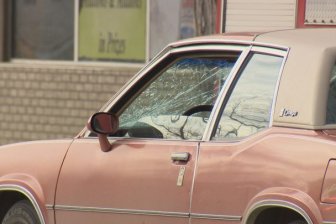Nearly 600 stolen cars from GTA seized from Montreal port
Between mid-December and the end of March, police inspected about 400 shipping containers at the Port of Montreal and found nearly 600 stolen vehicles, most of them from the Toronto area.
The operation showed how Canada’s second-largest port has become a key transport hub for stolen vehicle exports. Police say that’s because of the port’s strategic location and large container volume. And while authorities say they are doing what they can to stop the scourge of auto theft, experts say jurisdictional limitations, a lack of personnel, and organized crime are standing in the way.
“It’s a very large port,” said Bryan Gast, vice-president of investigative services at Équité Association, an anti-crime organization composed of insurance companies. With rail and road links to the Greater Toronto Area — where many vehicles are stolen — Montreal’s port is “conveniently located” for criminals.
An Ontario Provincial Police investigator for more than 20 years, Gast said stolen vehicles are packed in shipping containers in the Toronto area, given falsified paperwork, including customs declarations stating the cargo is legitimate, and then shipped to the port by rail or truck.
Gast’s organization participated in Project Vector, the Ontario Provincial Police-led operation at the port that recovered 598 stolen vehicles between December and March.
Aside from its location, the sheer volume of merchandise moving through the port is exploited by criminals. Last year, around 1.7 million containers transited through the Port of Montreal, including 70 per cent of Canada’s legal vehicle exports, according to port authorities. That’s around a million more containers than Canada’s next two largest East Coast ports combined.
Car thieves, Gast said, “can intermingle their containers that contain these stolen vehicles in among the trade that’s legally flowing out of Canada.”
More on Toronto
The Port of Montreal said it works closely with police and border services, but port officials can open containers only to save someone’s life or prevent environmental damage, said spokeswoman Renée Larouche.
More than 800 police officers from a range of agencies have access cards to enter the port and, if they have a warrant, open containers, Larouche said. However, in customs-controlled areas of the port, only border officers can open containers without a warrant.
Three-quarters of the vehicles recovered during Project Vector were from Ontario, including 125 from the Peel Region, which has become the province’s car theft capital, according to local police.
Patrick Brown, the mayor of the Peel Region city of Brampton, said a lack of container screening at the Montreal port has made exporting stolen vehicles a lucrative, low-risk endeavour.
He said car theft is a more serious problem in Canada than in the United States because American authorities use scanning equipment on a much larger percentage of shipping containers.
“Organized crime doesn’t take that risk in the U.S.,” he said in a recent interview. “In Canada, we scan less than one per cent” of containers.
Brown said the recently announced $28 million in federal funding for the Canada Border Services Agency should be used immediately to buy scanners for the Montreal port and the two Toronto-area shipping hubs where containers move from trucks to trains. As well, he said, police should be able to enter customs-controlled areas of those facilities without a warrant or special permission from the CBSA.
“People will have tracking devices in their cars, they’ll track them to the intermodal hub, or track them to the port and local police can’t even go on and do anything about it,” he said.
During Project Vector, Peel Police said their access to containers at the port was restricted by CBSA’s “very limited resources,” Cst. Tyler Bell-Morena wrote in an email.
The CBSA wouldn’t say what percentage of containers are scanned every year, but Annie Beauséjour, the agency’s regional director general for Quebec, said all containers flagged by police are inspected by border agents.
“We would like to be able to scan all the containers leaving the country; unfortunately, this is not something realistic,” she said in an interview, adding that the border agency isn’t allowed to slow the flow of trade.
So far this year, the CBSA has seized 300 stolen vehicles from Toronto-area rail yards, and in 2023 it recovered 1,200 stolen vehicles at the Montreal port.
But port interceptions are a “last resort,” she said, adding that it’s important to recover stolen vehicles before they reach the shipping docks.
That’s because once a container filled with stolen cars reaches the Port of Montreal, there aren’t enough border guards to check it, according to the union representing border officers. In fact, last February, there were just eight border officers working at the port, and the agency lacked space to hold more than six recovered stolen vehicles at a time, union president Mark Weber recently told a parliamentary committee.
The lack of resources in Montreal is typical of port cities worldwide, said Anna Sergi, a criminology professor at the University of Essex in the United Kingdom who studies organized crime, in a recent interview.
Customs agencies are “focused on import. No one is focused on export. Export is not a viable thing to invest in because it’s someone else’s problem,” she said. “The only country that does a little bit, and just a little bit, of investigation on exports is the United States”
Sergi, who wrote about stolen vehicle exports from Montreal in a 2020 report on corruption and criminality at seaports, said only two or three per cent of inbound containers are inspected, and the percentage is even lower for those leaving the country.
Organized crime has long been present on Montreal’s waterfront, she said. The West End Gang, Montreal’s so-called “Irish mafia,” as well as the Italian mafia have both been involved in drug importation using corrupt customs agents and port workers.
Insp. Dominique Côté of the Montreal police said, “we have no information that leads us to believe that the Port of Montreal has been infiltrated by organized crime, or that that’s the reason these vehicles are found in Montreal.”
Brown said he’s skeptical of claims that border agents can’t do more — or that organized crime isn’t part of the reason Montreal’s port is so popular with criminals.
“When I see CBSA and the Port of Montreal say why they can’t do it, it makes me highly suspicious of why they’re defending a status quo that has been the most lucrative gift to organized crime in Canadian history,” he said.
View original article here Source












